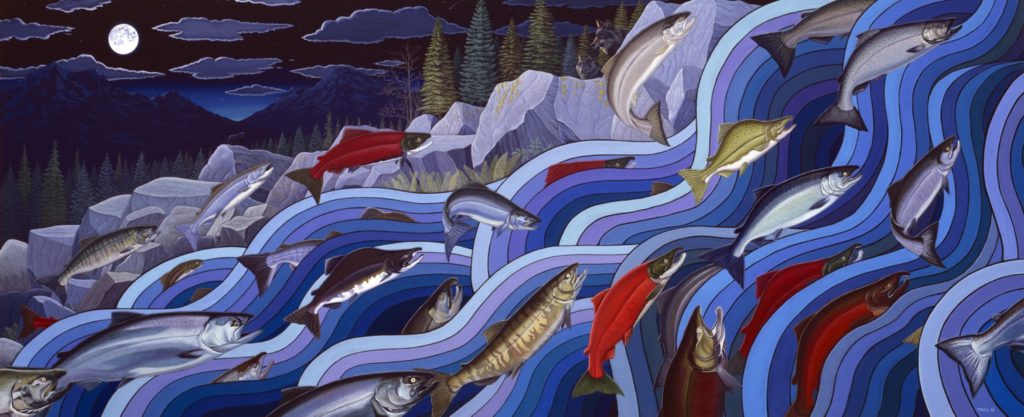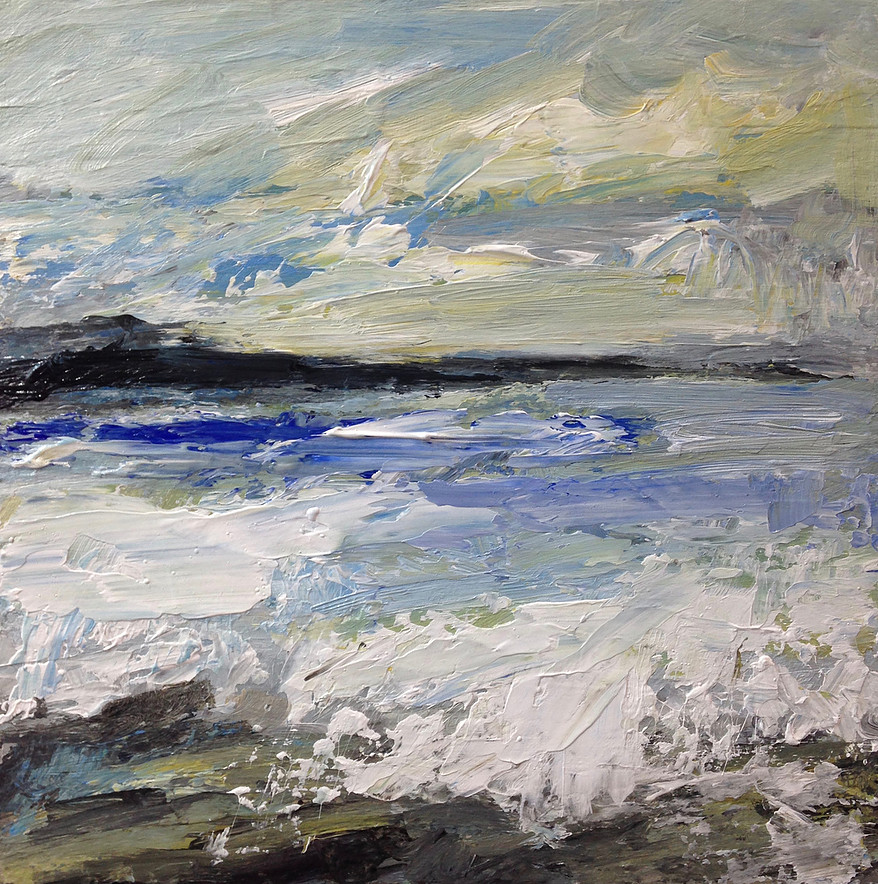The MV Columbia is the flagship of the Alaskan Marine Highway fleet and the largest. She is 418 feet long and 85 feet wide, with a draft of 17 ½ ft. The Wrangell Narrows is a winding channel between Mitkof Island and Kupreanof Island in the Alexander Archipelago and is only 300 feet wide at it’s narrowest point – barely wide enough to accommodate the ferry. It is used by fishing boats and cruisers and does not allow for the passage of the larger cruise ships. 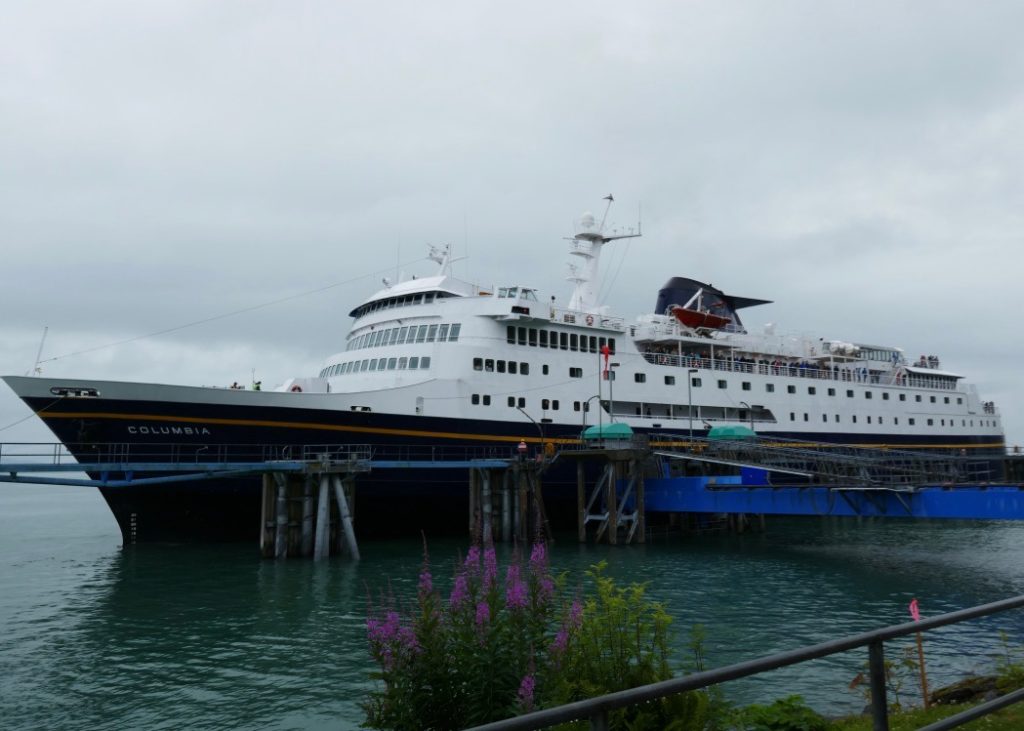
Known to Marine Highway officers as “The Ditch,” the waterway wends its way around islands, boulder fields, rock ledges, reefs, shoals, and mudflats for twenty-two and a half nautical miles.
It is nearly impossible to turn around and retreat once a ship is committed to the channel, regardless of fog, heavy snow, or complete darkness without moonlight. 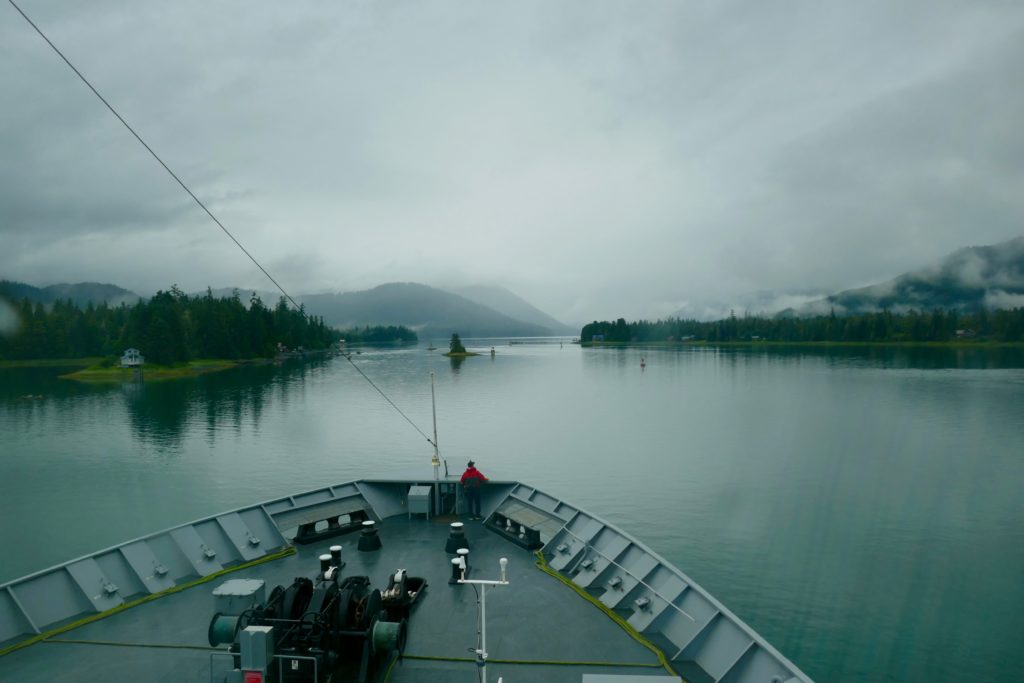
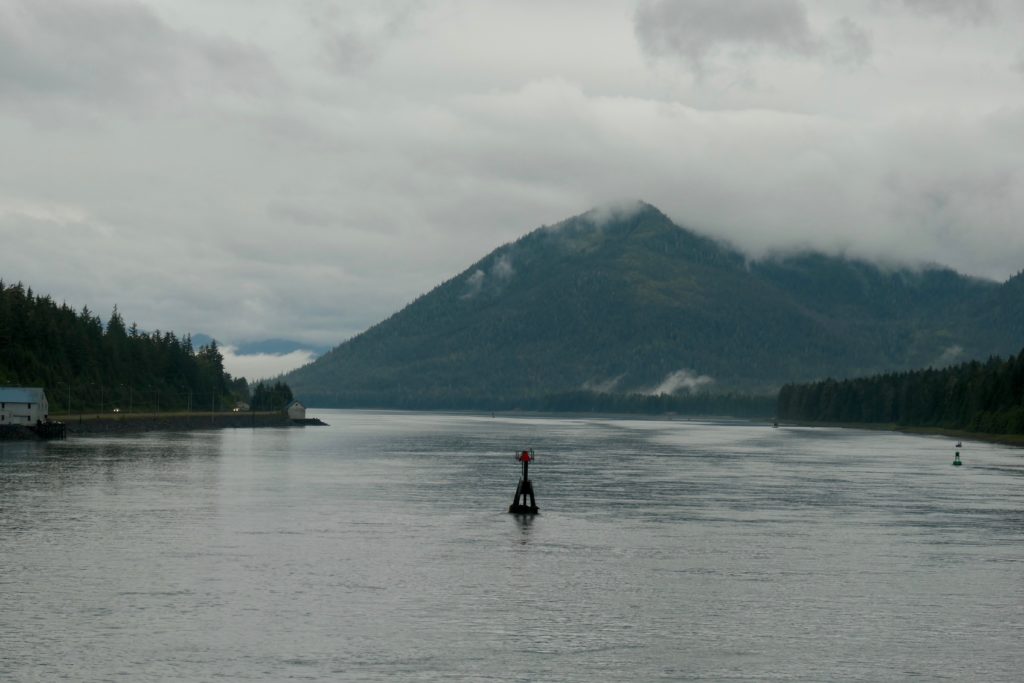 In the Narrows
In the Narrows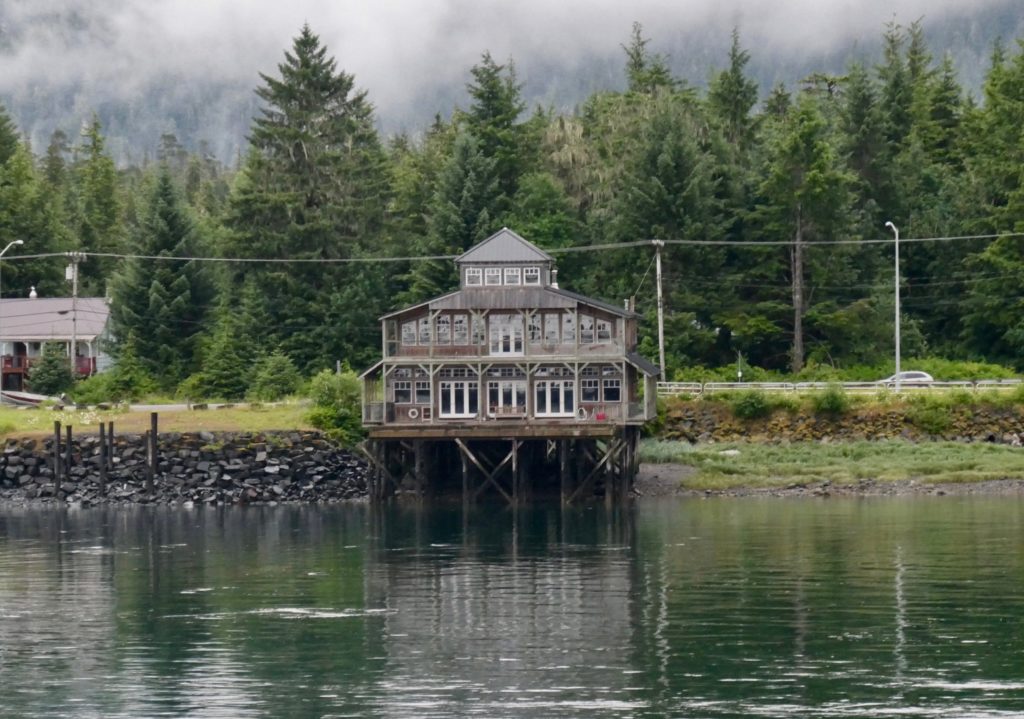
With tides that can range from a high of 21 feet to a low of -4 feet in one day, the water rushes through the Wrangell Narrows adding to the navigational challenges. A ship must conduct its business and be out of the narrows before the water level becomes too shallow for transiting.
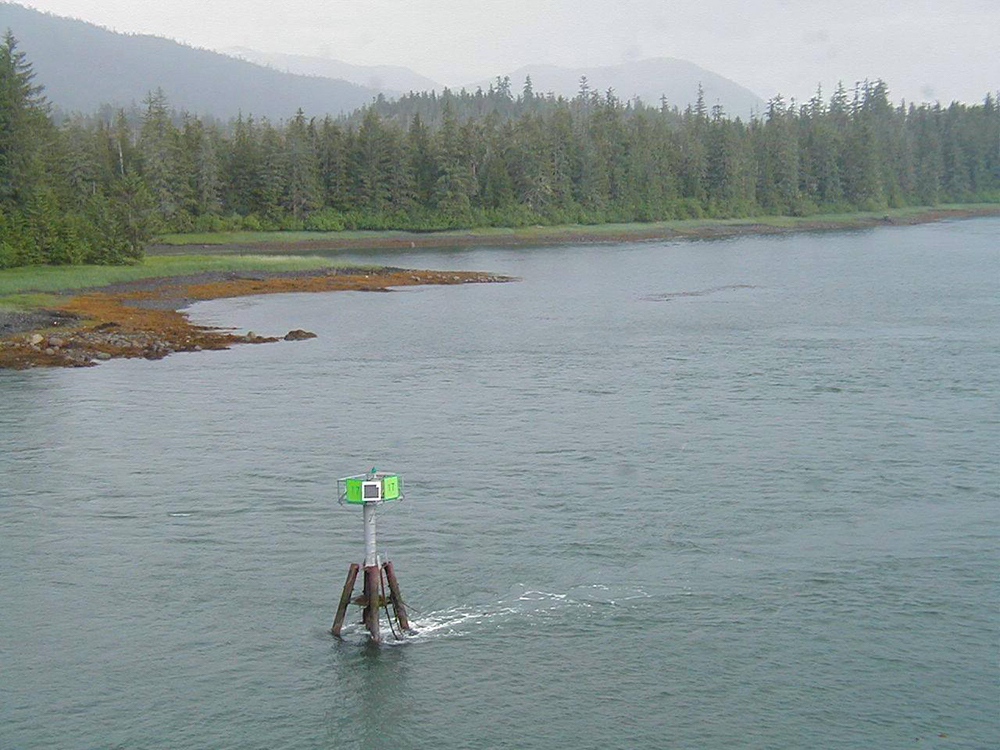
No wonder many a captain has heaved a sigh of relief when, in impenetrable fog so thick they are totally reliant on radar and their skill, they see the amber dock lights of Petersburg showing faintly through the murk a few feet in the distance. As one captain said: “It sure does focus the mind”.
We left for Petersburg in daylight with no fog or snow in sight – just a clear run through the beautiful landscape. At times it seemed as if you could almost jump ashore the ship was so close to the land. Not that you would want to – apparently the islands are inhabited by brown bears who have wiped out the black bears, the wolves and the deer and reign supreme
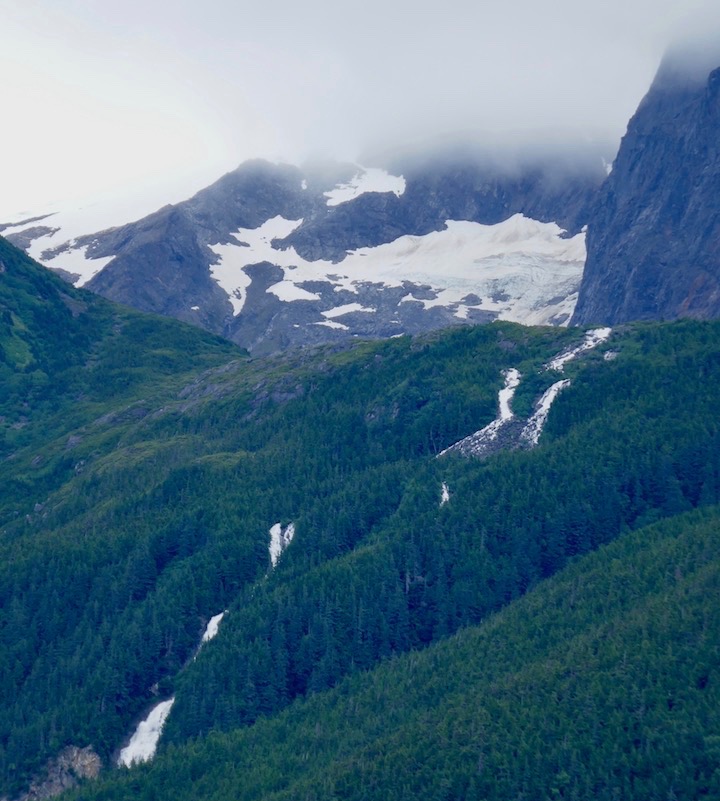
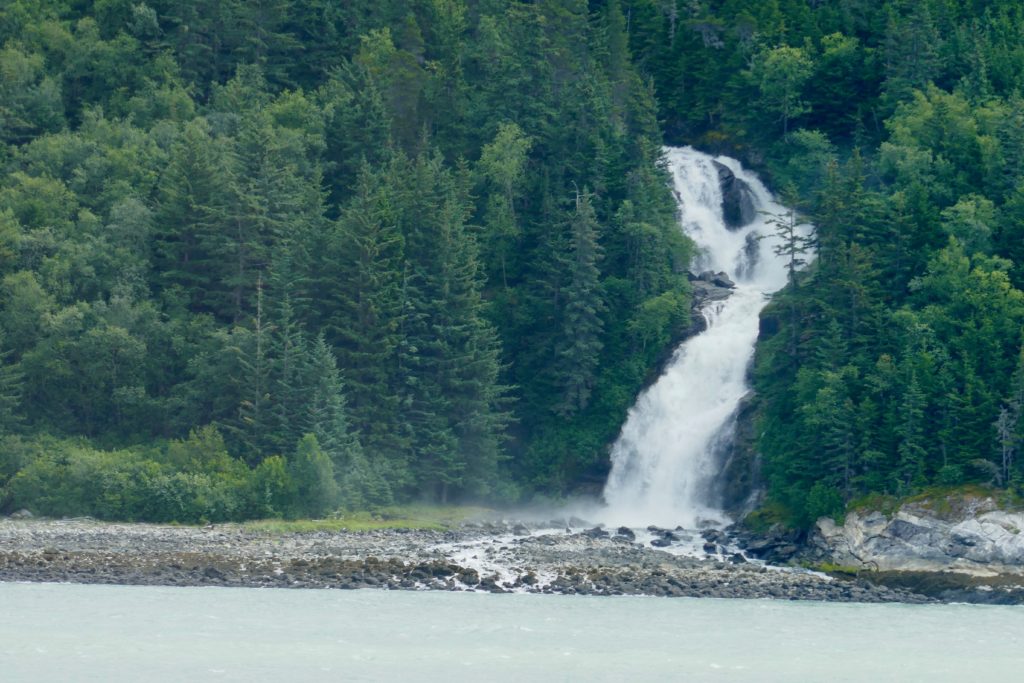
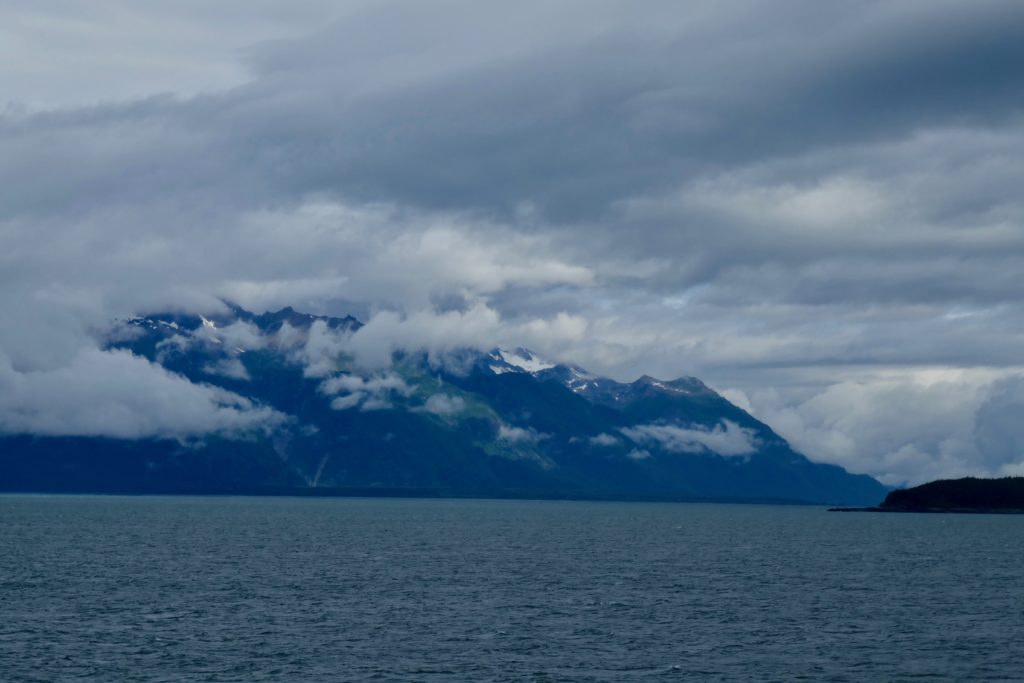

Petersburg is an island community that makes a living from the sea. In the nineteenth century, Peter Buschmann, a Norwegian immigrant, settled there, building a cannery, sawmill, docks and the early structures. The settlement was named Petersburg after him, and it flourished as a fishing port. The town attracted mostly immigrants of Scandinavian origin, thus giving Petersburg the nickname “Little Norway”. Three other canneries were built and the four have operated continuously since.
Commercial fishing is the dominant economic driver of Petersburg’s economy. The top producers harvest well over a million dollars of seafood each and every year. The main producers in Petersburg are the 58-foot limit ‘seiners’. These 58-footers harvest salmon, halibut, black cod, king, tanner crab, and herring. Many of them travel west to trawl, longline and pot cod in the western Gulf of Alaska and the Bering Sea. The fleet now boasts crew jobs that approach six figures.
There are three beautiful harbours, which attract the smaller cruise ships, private yachts and pleasure boats to town in the summer months.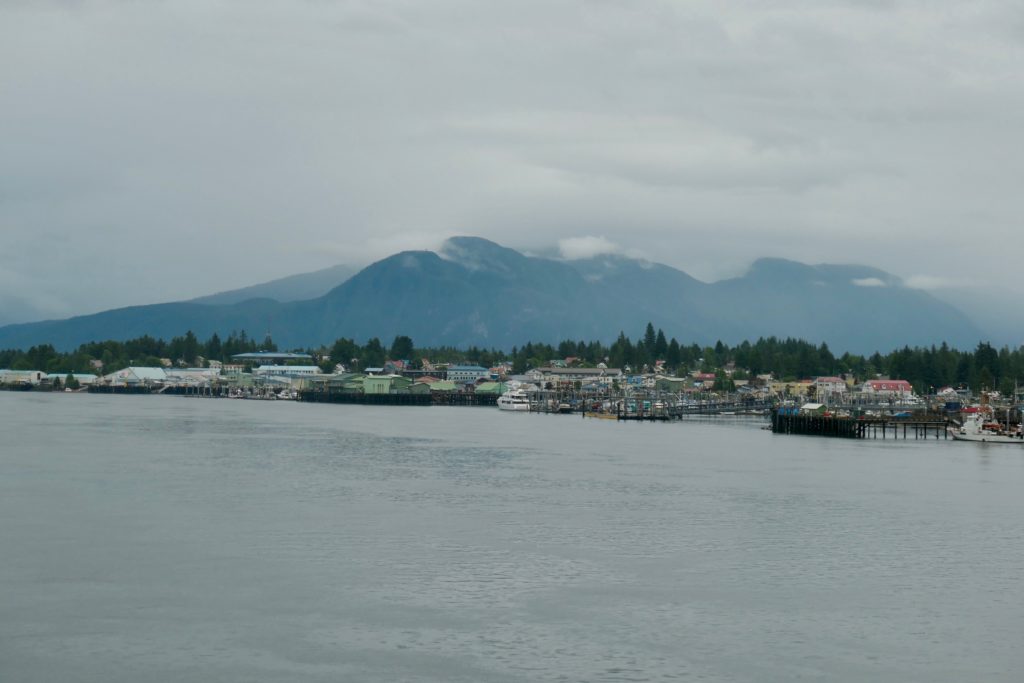
We arrived at around 7.30pm and only stayed for 45 minutes so didn’t have time to go ashore. Instead we opted to visit the dining room where we had a magnificent meal as the ship wended it’s way towards Juneau, the next stop. It arrived there at 3.15 am, by which time we were well tucked up in bed! 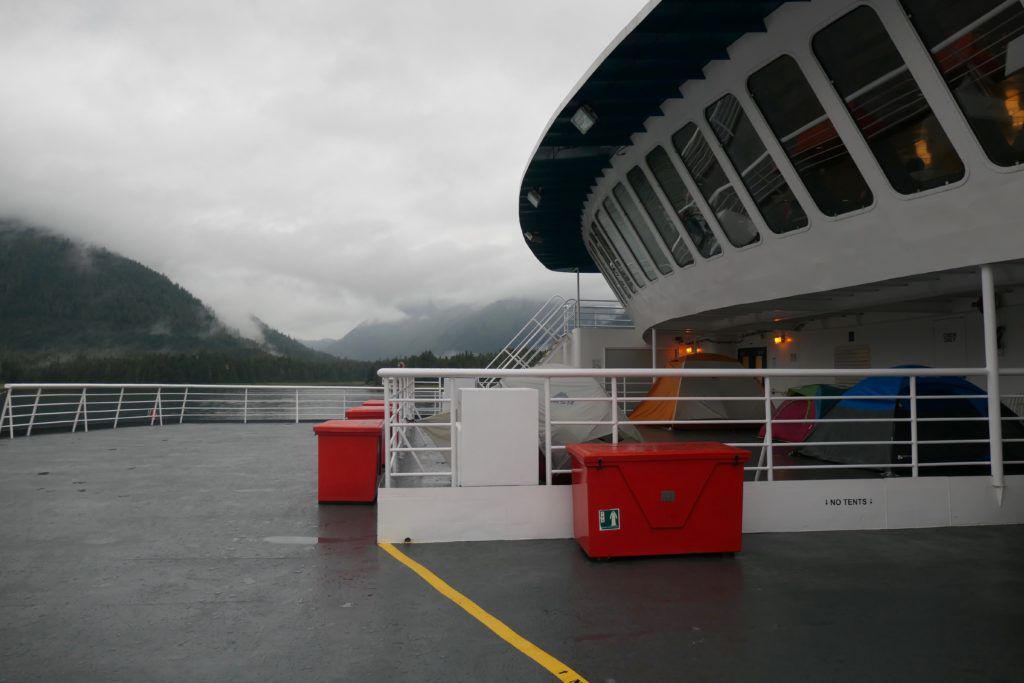
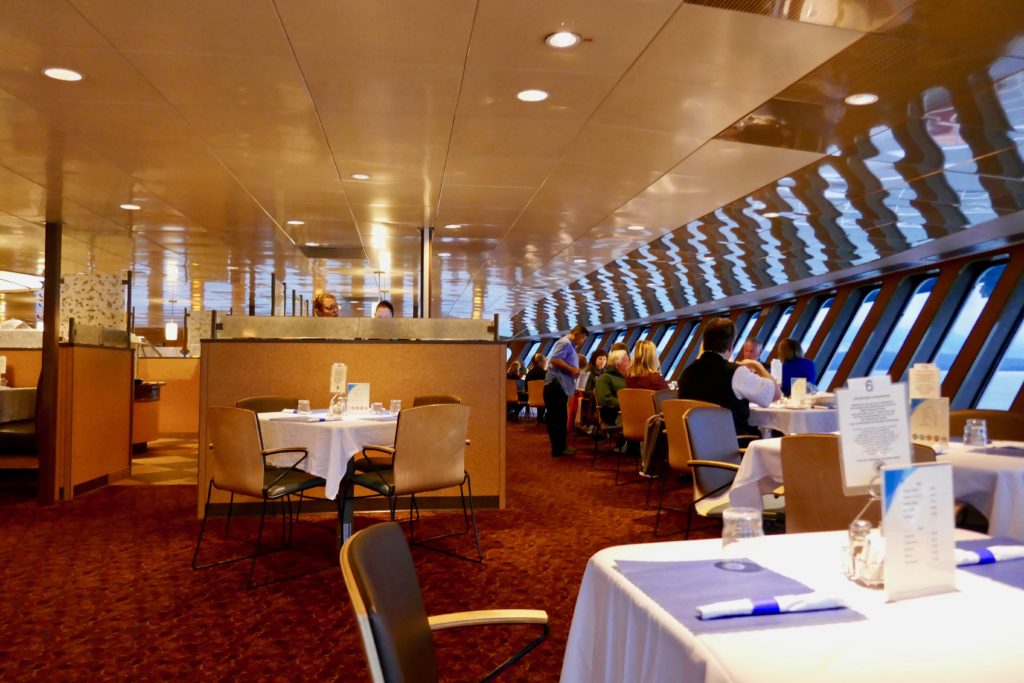
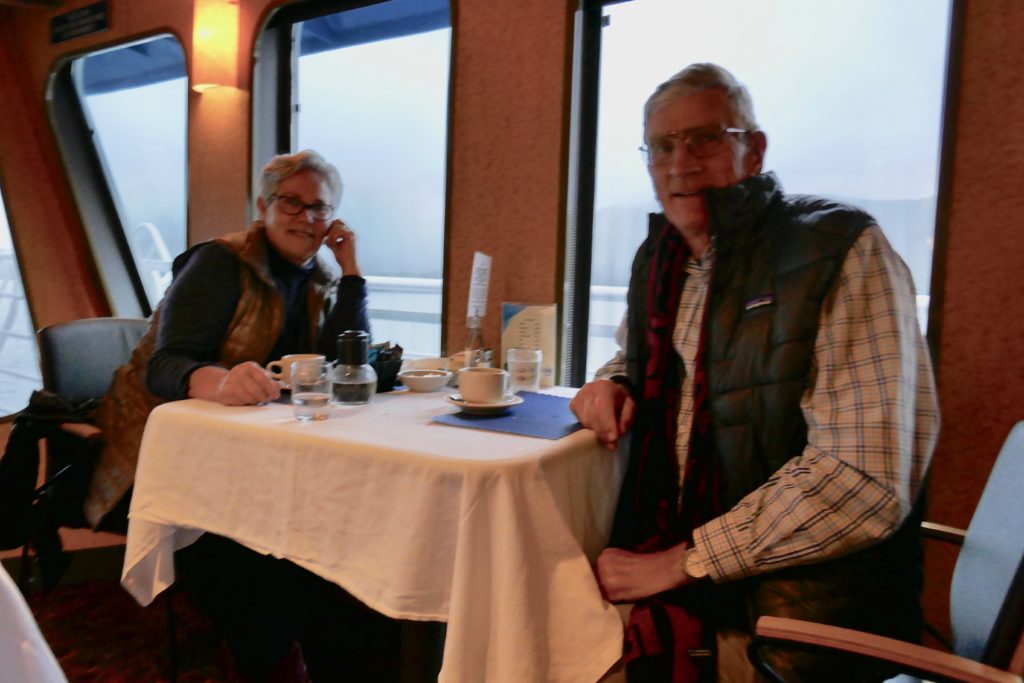
Our next stop was the Port of Haines, one of the most beautiful ports of the Inside Passage. Their docking facilities only allow for one large cruise ship and possibly a small ship so unlike many other ports you may visit, the town is less crowded.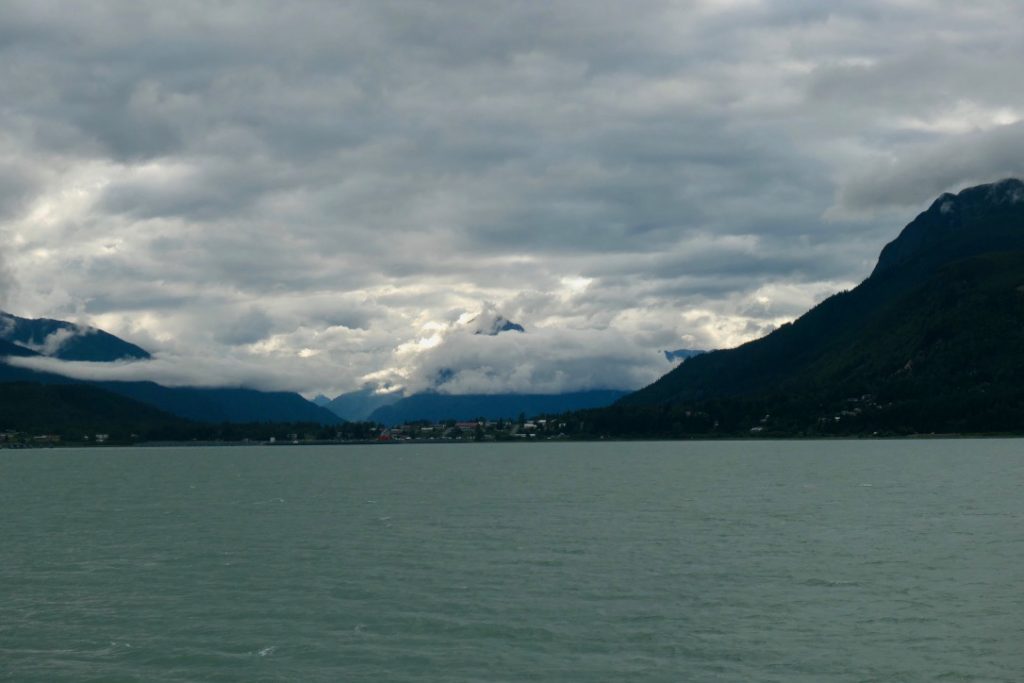
In sharp contrast to Skagway. We had enjoyed our time in Skagway in 2010 and had bought some lovely pieces from the interesting and helpful galleries, so had decided to go ashore there and have a bit more of a look. 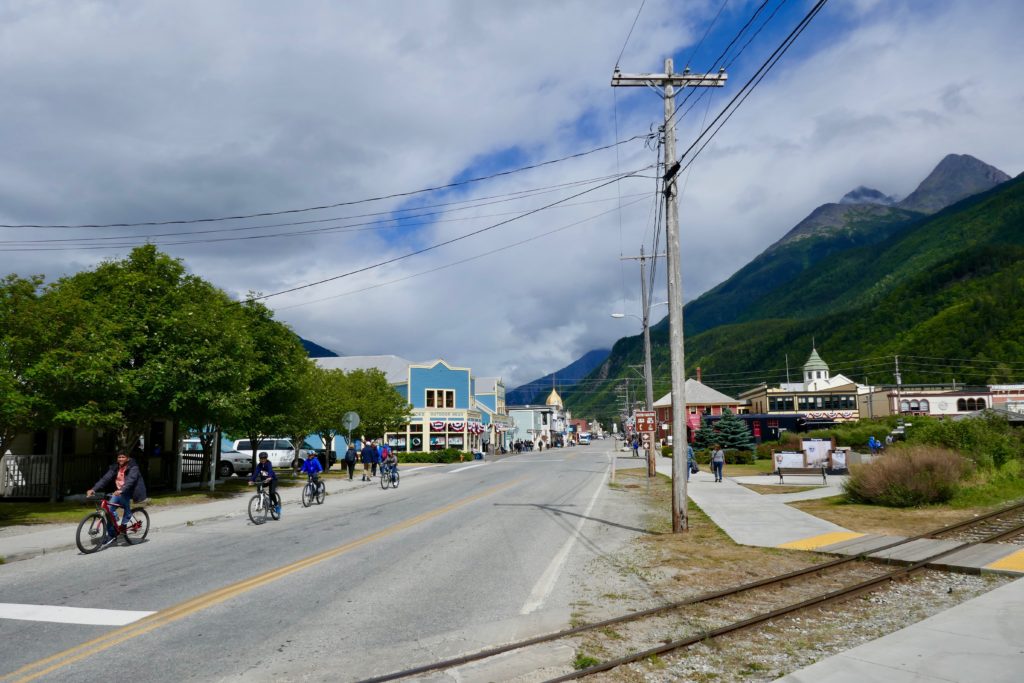 The town had changed almost beyond recognition from a shopping point of view. We later learned that the cruise companies buy up many of the shops and galleries and put in their own people and merchandise. In the winter months the people and the shops move to the Caribbean and then back again the following summer. The result is lots of diamonds and furs and artwork that is not unique and can be picked up at any of the ports. The salespeople tend to be high pressure and have little knowledge of the pieces or the artists. We found a nice pair of orcas done in baleen and bought Andrew a lovely knife for his birthday but the town was crowded and pushy and we had no desire to stay.
The town had changed almost beyond recognition from a shopping point of view. We later learned that the cruise companies buy up many of the shops and galleries and put in their own people and merchandise. In the winter months the people and the shops move to the Caribbean and then back again the following summer. The result is lots of diamonds and furs and artwork that is not unique and can be picked up at any of the ports. The salespeople tend to be high pressure and have little knowledge of the pieces or the artists. We found a nice pair of orcas done in baleen and bought Andrew a lovely knife for his birthday but the town was crowded and pushy and we had no desire to stay. 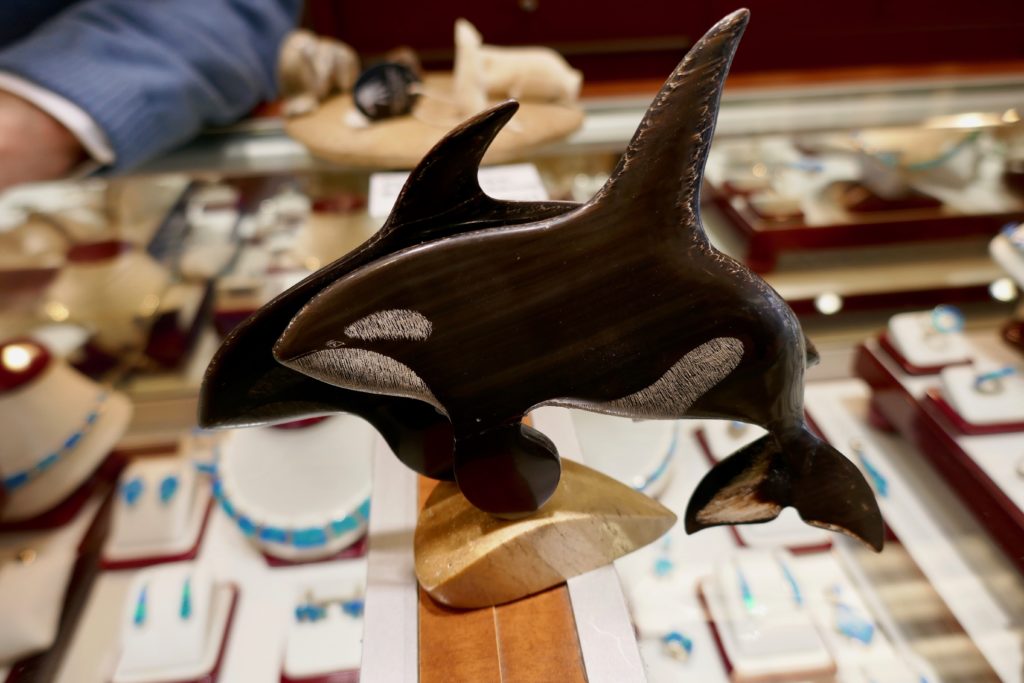


The cruise ship industry is a double-edged sword. In many cases the economic contribution brought in by the hordes of tourists is dwarfed by the disruption caused each holiday season. Unlike other visitors, cruise passengers tend to enjoy a vast array of amenities on board reducing their need to spend money ashore and when they do, it is often in facilities owned by the cruise companies. Most Alaskan towns are small and the impact of several thousand people completely overwhelms them.
Nevertheless there is a race on to build bigger docks to encourage the bigger ships and, whilst the ships are discouraged from staying overnight, the hours are being extended in most places from 10am to 10pm. The places you can go and still find the unhurried relaxed atmosphere of a true Alaskan town are fast disappearing. It’s a pity that, like Haines, some of the towns don’t put a limit on the number of ships docking at the same time and thus get the benefits without destroying what attracts people in the first place.
Our trip down to Sitka was also very interesting as we sailed through more picturesque narrows. Squeezing to only 300 feet wide in one spot and a shallow 24 feet deep it is notoriously difficult to navigate due to raging currents and whirlpools. All vessels wait until slack tide when the currents are at their slowest to start manoeuvring. The narrow passage wanders through the heavily forested steep hills of the Tongass National Forest.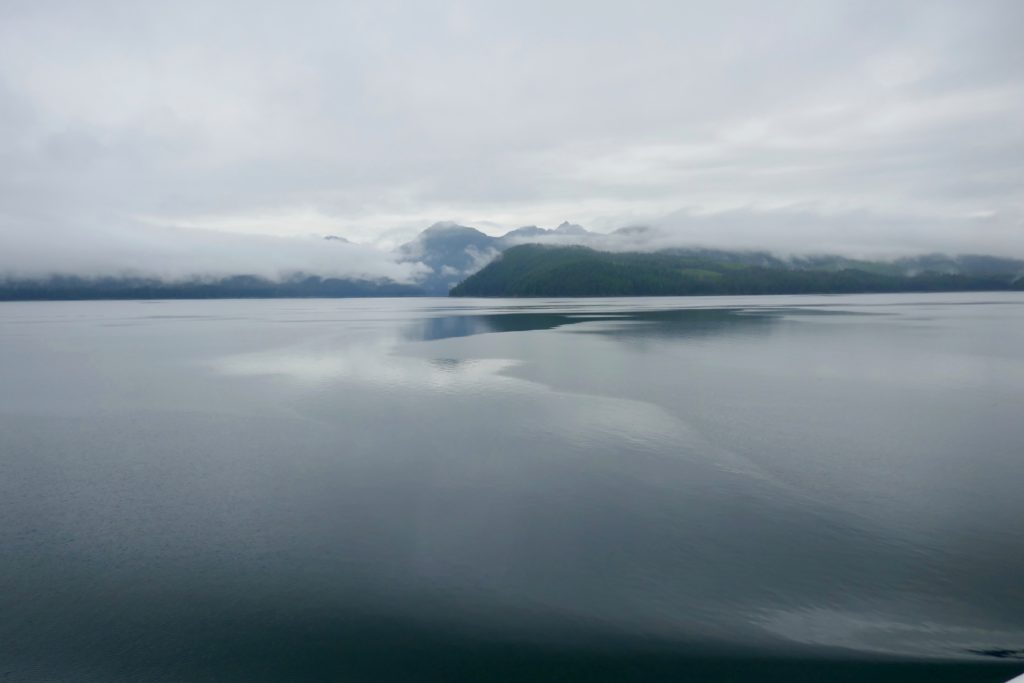
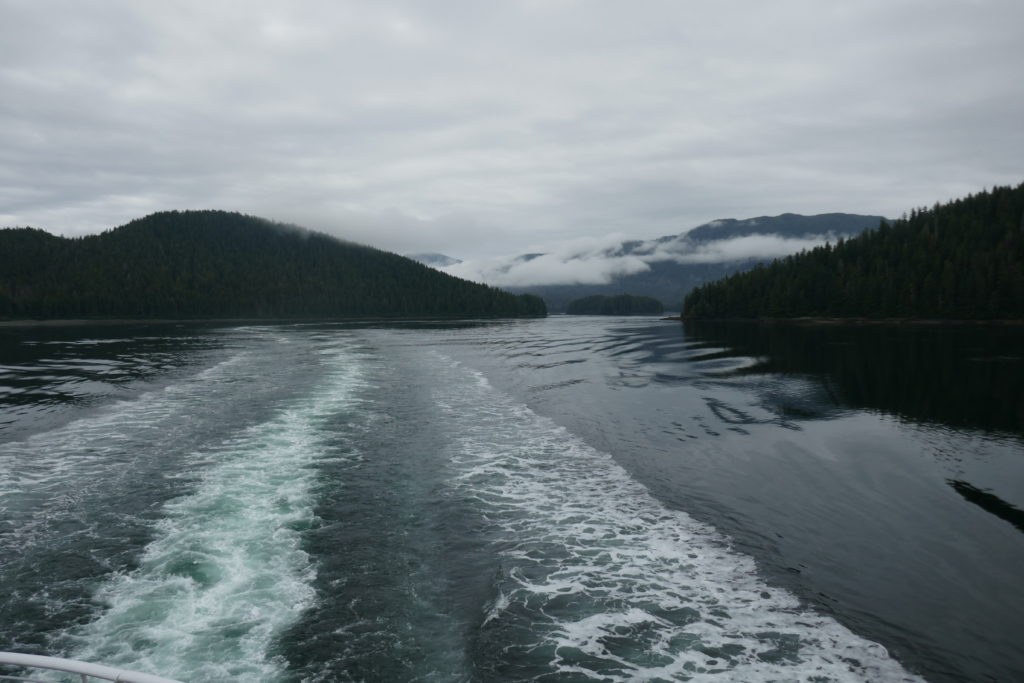
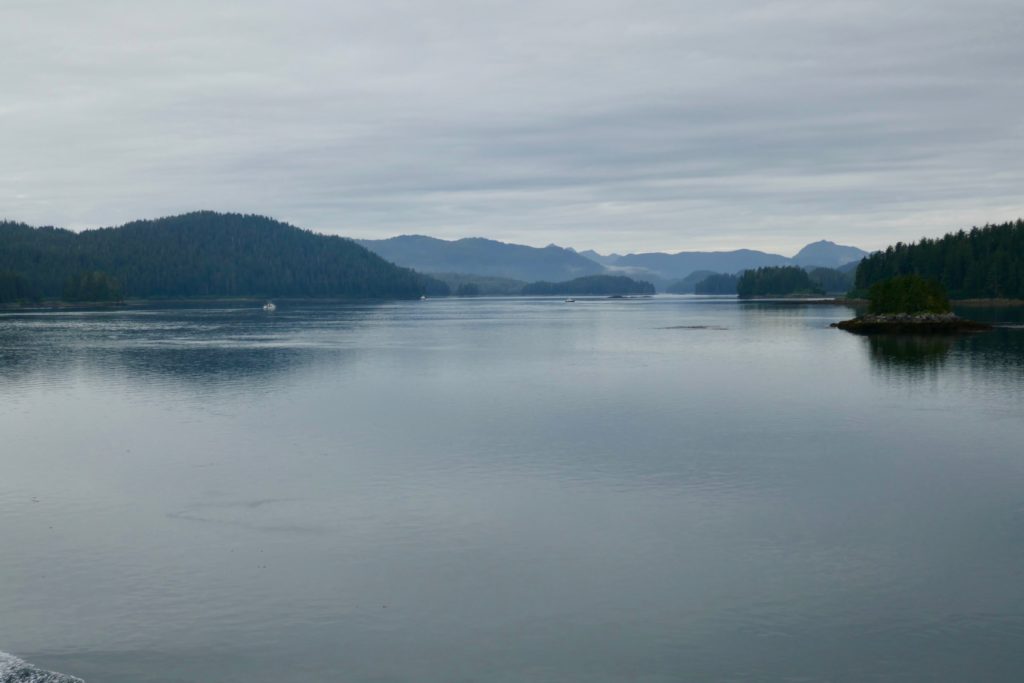
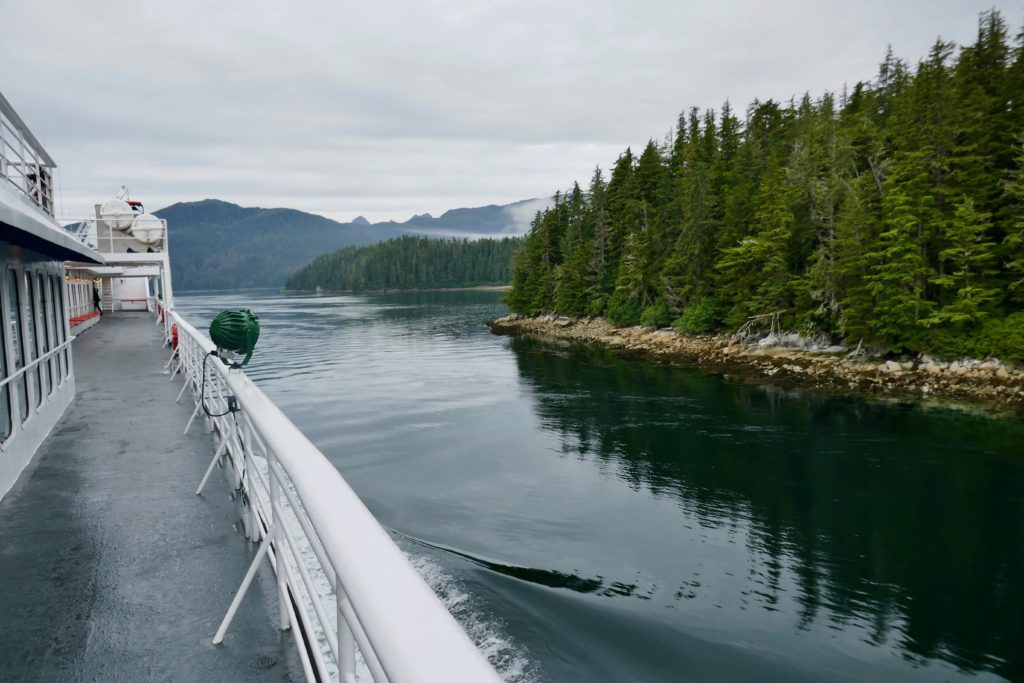
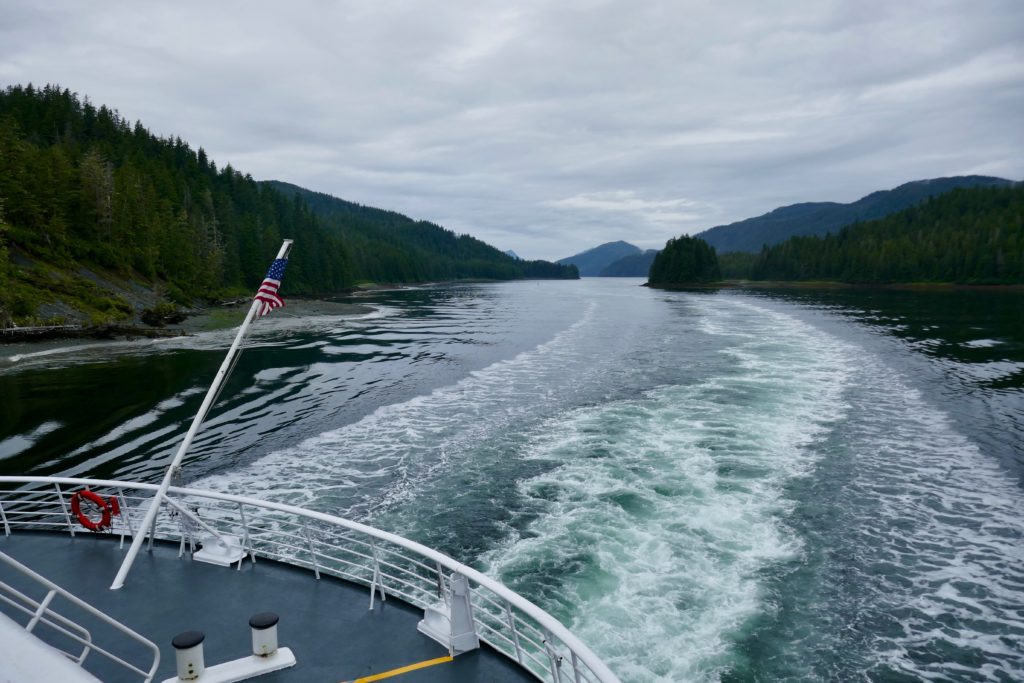
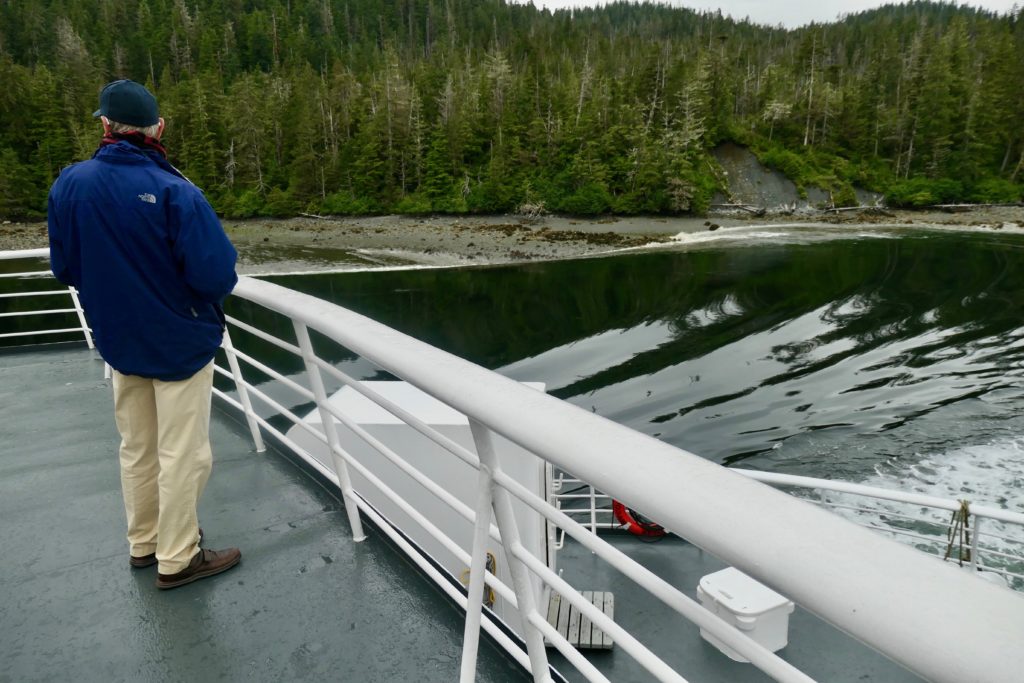
Walking the streets of Sitka, you may find it hard to believe that this quiet coastal community was once the hub of the West Coast: a center for trade, diplomacy, and the arts. When San Francisco had less than 10 residents, Sitka was home to 800 Russians, Europeans, Tlingits, and Aleuts. The oldest town on the West Coast, it was the capital of Russian America—called New Archangel—and was booming from the early 1800s through the United States’ purchase of the territory in 1867.
Sitka was our favourite stop in Alaska. We checked in to our hotel, the Super 8 (definitely budget end but clean and with good facilities), picked up a hire car from the airport and headed in to town. The streets of Sitka are relatively uncrowded and the Russian influence is quite noticeable.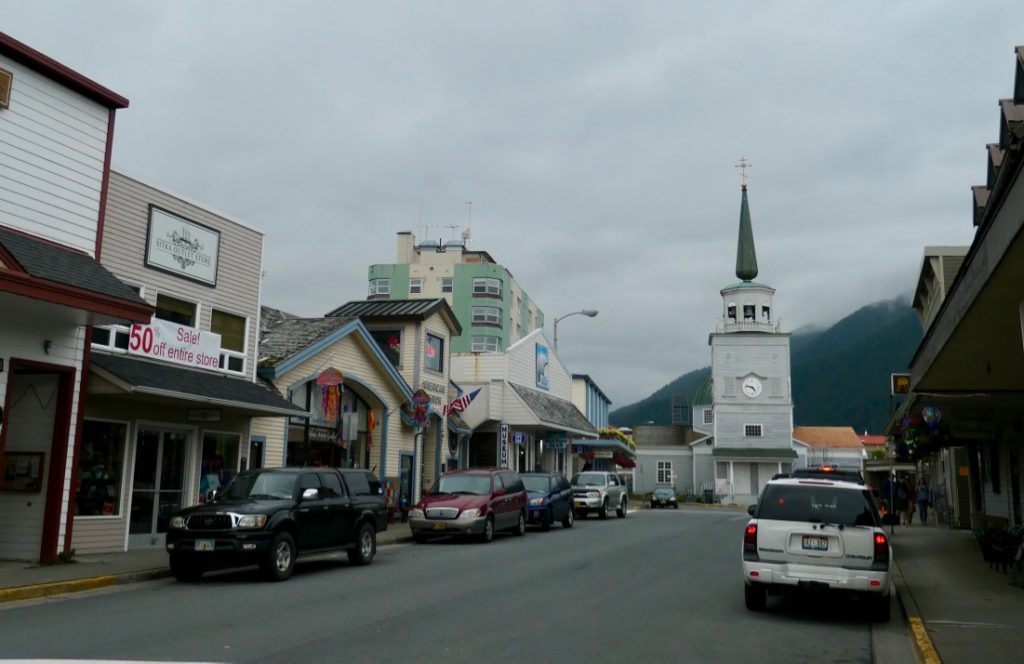 Here many of the gallery owners have banded together and refused to sell out to the cruise companies and the number of ships is limited so shopping is pleasant. We found some lovely pieces – some of which we bought and some we just lusted after. Our first stop was Robertson’s Gallery where we met Gay, who showed us a number of pieces by local artists. One in particular took our fancy. It was a brown bear carved in soapstone and was one of the nicest we had seen. Gay gave us a lot of information about the local galleries who had held out and refused offers to sell and we worked our way down the street visiting them. We found a lovely copper necklace crafted by one of the local artists, which we bought for Christine’s birthday and some beautiful pieces in whalebone. As there was some question about getting whalebone back into Australia we bypassed them and returned to our bear.
Here many of the gallery owners have banded together and refused to sell out to the cruise companies and the number of ships is limited so shopping is pleasant. We found some lovely pieces – some of which we bought and some we just lusted after. Our first stop was Robertson’s Gallery where we met Gay, who showed us a number of pieces by local artists. One in particular took our fancy. It was a brown bear carved in soapstone and was one of the nicest we had seen. Gay gave us a lot of information about the local galleries who had held out and refused offers to sell and we worked our way down the street visiting them. We found a lovely copper necklace crafted by one of the local artists, which we bought for Christine’s birthday and some beautiful pieces in whalebone. As there was some question about getting whalebone back into Australia we bypassed them and returned to our bear.
The bear was sculpted by Dale Hanson, an accomplished sculptor, carver and artist, who has certainly led a life of adventure. He is a black belt martial artist, writes literature and poetry, parachutes, flies airplanes and gliders, does aerobatics and is a Special Forces underwater diver. He is also a member of MENSA.
During the Vietnam War, Dale was a highly decorated Green Beret who served three years as a commando in the famous SOG program, whose missions involved extremely dangerous raids far behind enemy lines. On one of these raids, Dale had his right hand mangled by a burst of machine gun fire earning him a purple heart . It is ironic that he became a sculptor, a field in which one’s hands are so critical. Most of his sculptures are of wildlife and can be found in collections all over the world
He lives in Sitka and has his studio there. He has a reputation for being somewhat reclusive so our request to meet him and look over his studio was doubtfully received by Gay. To all our surprise he agreed and asked us to come around the following evening. We finalised our purchase of the bear, organised it’s shipping and headed for the docks for dinner on the waterfront. A table overlooking the water, a gin and a whiskey, two seafood jambalayas and a couple of desserts saw us well satisfied with our day. 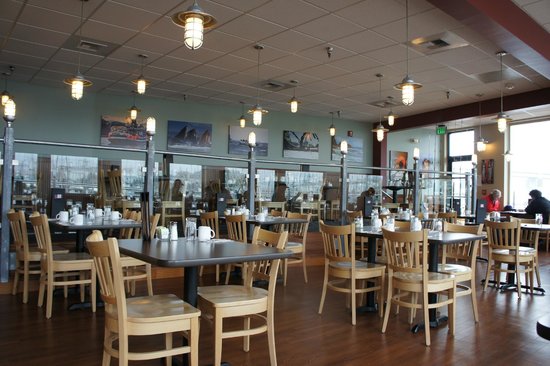
The next day we had decided to go to the Fortress of the Bears, where they rescue bear cubs whose mothers have been killed. It was not well marked and we were busy looking at the scenery so overshot the mark and ended up in a parking area for hiking through the National Parks. 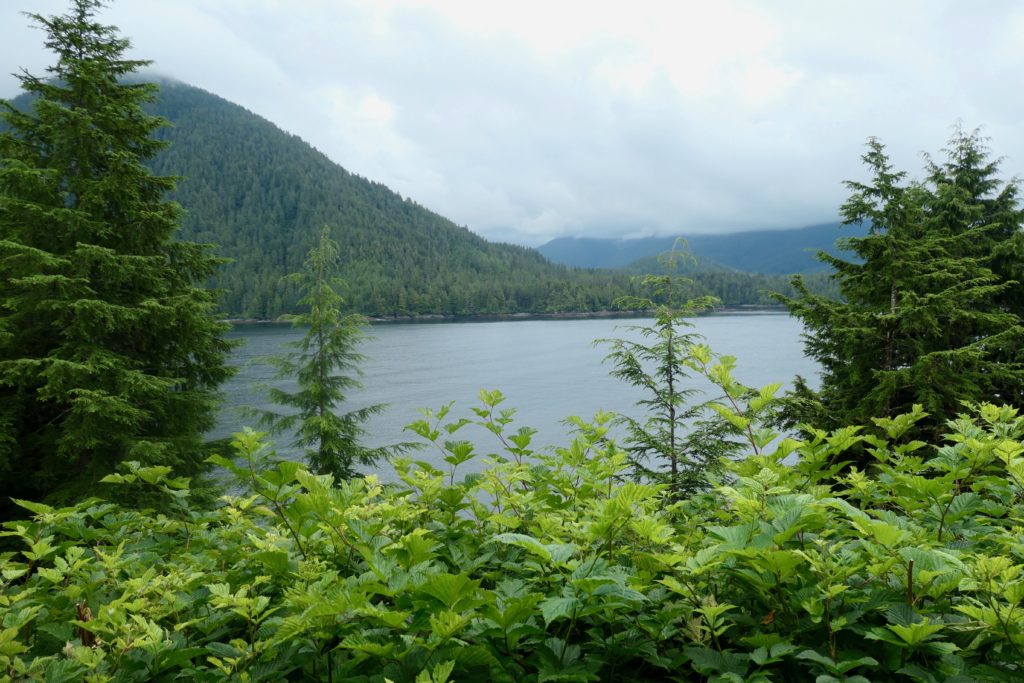 The paths looked inviting and we were contemplating going for a bit of a walk when a ute pulled up and one of the locals got out with his dog to take him for a walk. We couldn’t help notice that he was wearing a pistol in a shoulder holster and when we queried him he told us that there was bear scat everywhere and there had been lots of bear sightings. He regularly walked this area and had had several encounters with bears. He hadn’t had to shoot one but had come close. We decided to go back to the Fortress of the Bears and forgo the walk.
The paths looked inviting and we were contemplating going for a bit of a walk when a ute pulled up and one of the locals got out with his dog to take him for a walk. We couldn’t help notice that he was wearing a pistol in a shoulder holster and when we queried him he told us that there was bear scat everywhere and there had been lots of bear sightings. He regularly walked this area and had had several encounters with bears. He hadn’t had to shoot one but had come close. We decided to go back to the Fortress of the Bears and forgo the walk.
Whilst the theory behind the rescuing of the cubs sounds good, in practise it leads to a rather depressing result. It is customary when a mother is killed for the rangers to shoot the cubs rather than leaving them to the mercy of the elements and other bears. Once a bear cub has been taken into captivity it cannot be released back into the wild and has to be kept in captivity for the remainder of it’s life. There is a limited demand from zoos and often the area they are kept in is small. The bears at the Fortress of the Bears were in a much larger area but there was little for them to do and they could not get away from the viewing public. They displayed all the signs of bored animals – rocking and walking to and fro. Whilst the volunteers were obviously passionate about what they were doing we left feeling quite depressed.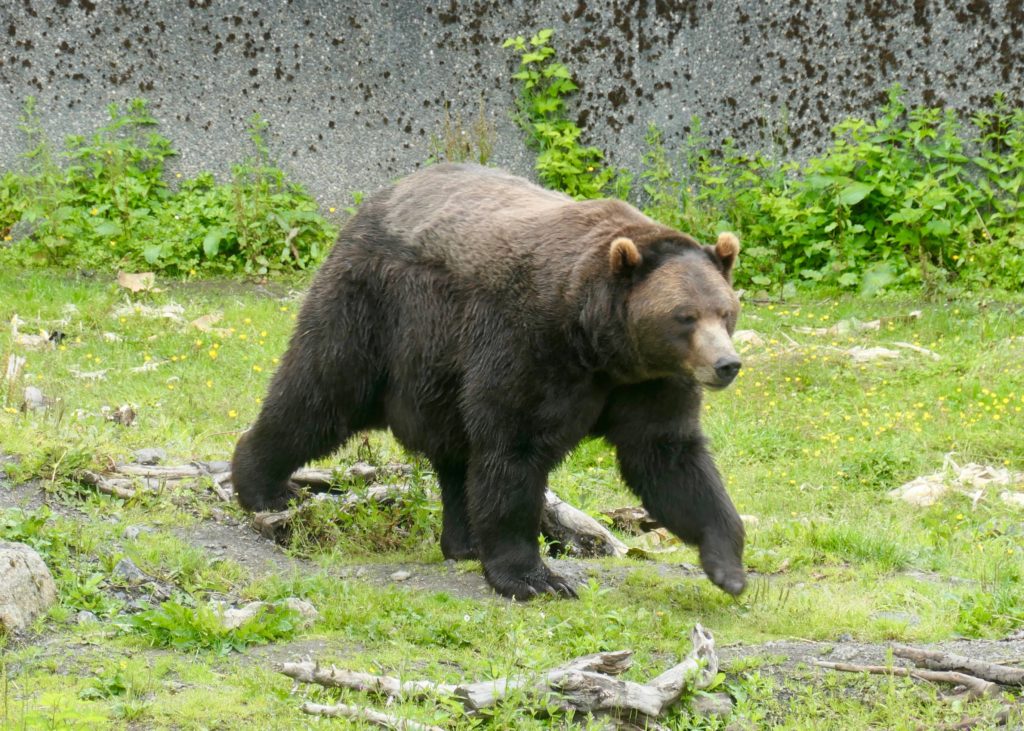
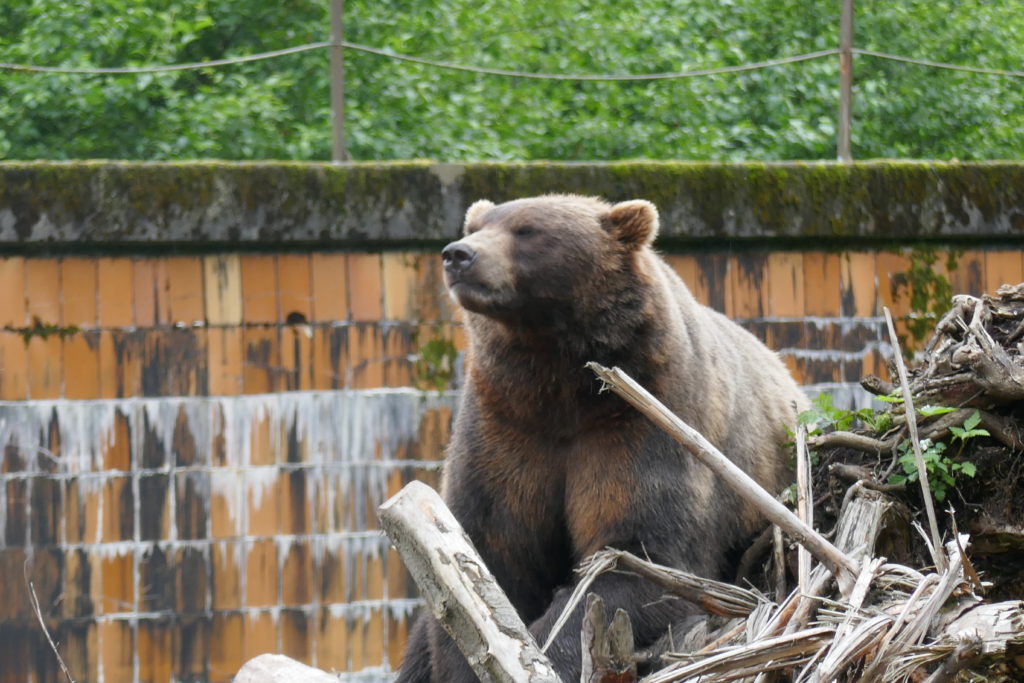
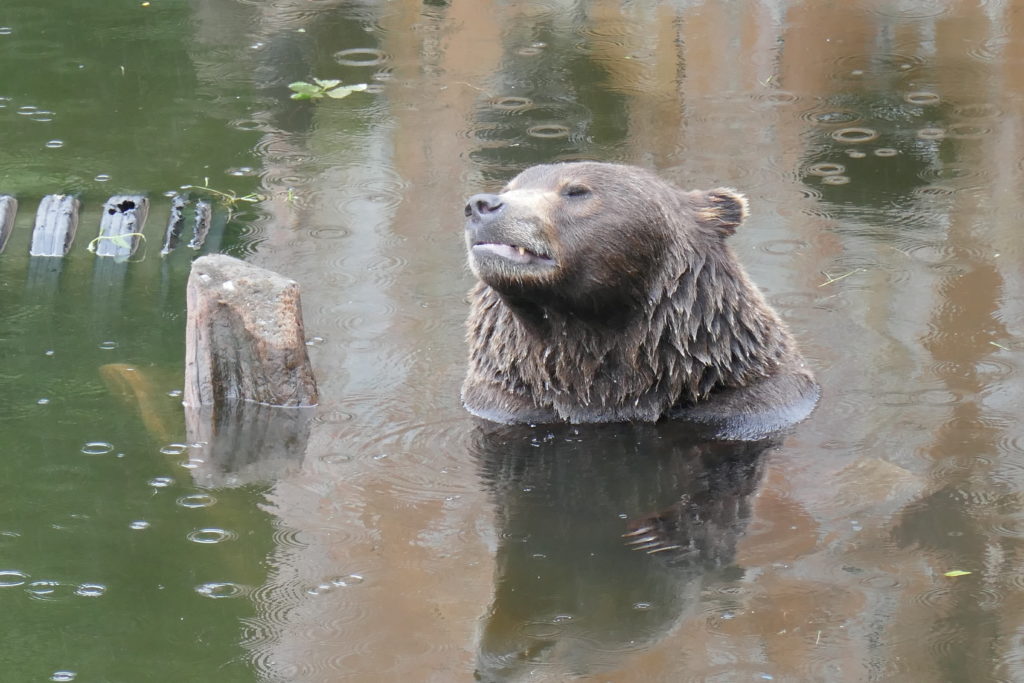
Rain was threatening and we had heard good things about the Sheldon Jackson Museum so decided to pay it a visit. It is housed in an interesting octagonal building and is listed on the National Register of Historic Sites. It was constructed in 1895 and is the oldest concrete building in the state.
The collection is extensive and includes items from Eskimo, Aleut, Athabascan, and Northwest Coast cultures. Masks, carvings, tools, and boats from all the cultures are exhibited here; highlights include an Aleut baidarka (skin kayak) and Tlingit dugout canoe. In the center of the gallery are drawers that contain artifacts organized by category (rather than culture) where you can compare Tlingit and Eskimo tools, children’s toys, and hunting and fishing tools. Because the items were collected at the turn of the century, you can trace the impact of European materials on Native crafts.
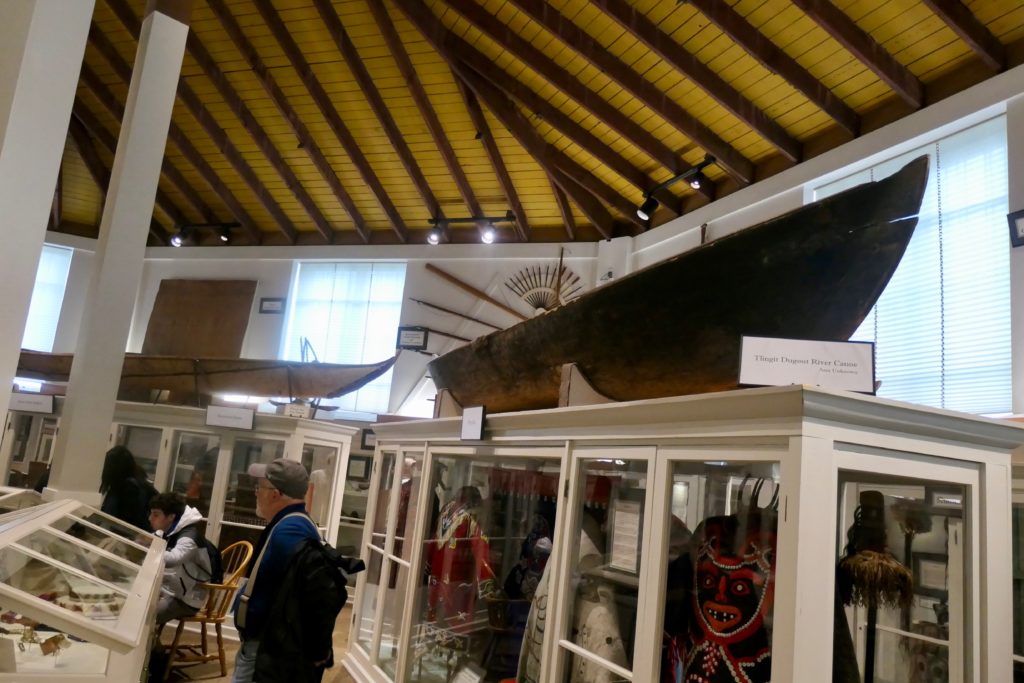
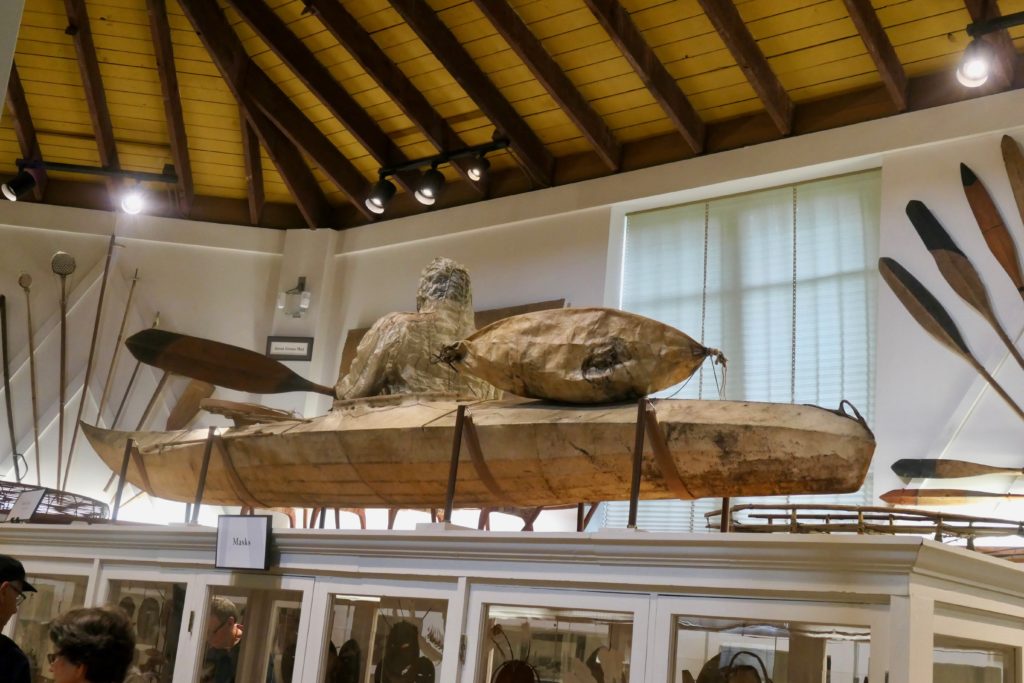
What was going to be a relatively short visit turned into hours and we only left because we had our appointment with Dale at 5pm.
That too was a short visit that turned into hours. He was a charming host, both interesting and interested. He had fought with Australians during the Vietnam war and had a great admiration for them. Our conversation ranged through the war, the military and into politics and Australia in general, his life after leaving the army and our travels through Alaska. We then went into his gallery where he had his latest works, mainly bronzes with some stone and wood.
He explained his process when approaching a new work, how he did a template then discussed it with a forest ranger, a zoologist and a kinesiologist to make sure he has it absolutely correct before casting or sculpting the piece. If he doesn’t, he explained, people write to him and tell him what he has wrong. One of the bronzes he had, which was lovely, was of a timber wolf at rest. He rather dejectedly told us that pieces like this were hard to sell as people wanted their wolves snarling and their bears attacking! He showed us some of his poetry – he has published several books – and we finally bade our farewells and left. It had been a most enjoyable visit.
We left Dale just before 8 o’clock and hastened to the Channel Club for dinner. It came highly recommended and when we got there we could see why. Located a few kilometres out of town it overlooks the water and has a varied menu of seafood and steak. It was packed but they managed to find us a seat and we had a couple of very good steaks washed down with red wine. They offer a free pick up and set down for those who want to indulge, which could prove very handy if you were after a night out on the town.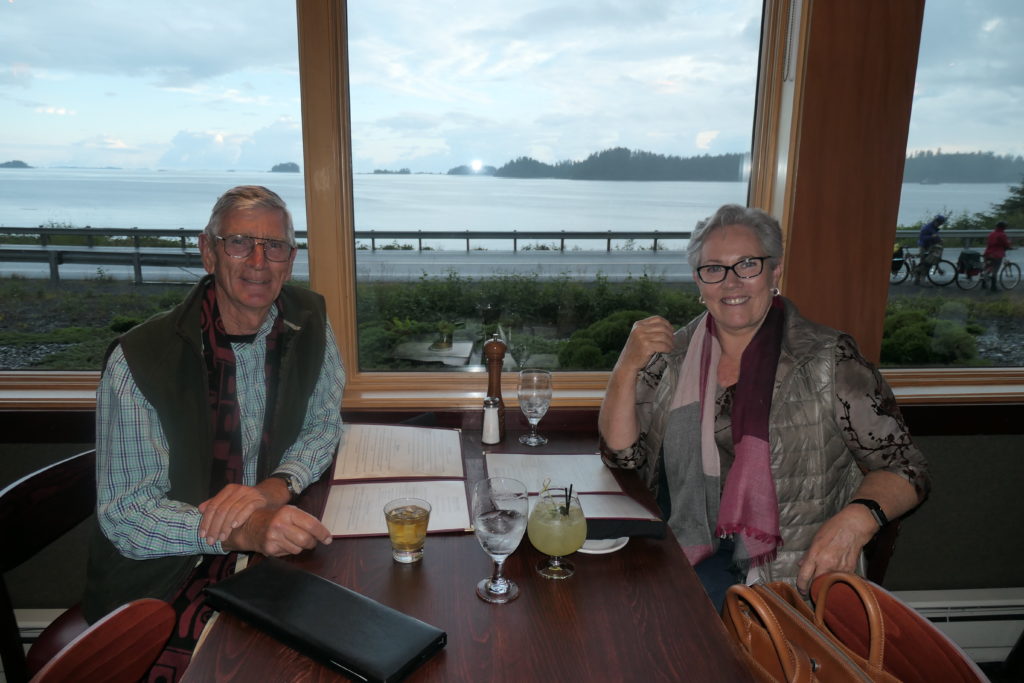
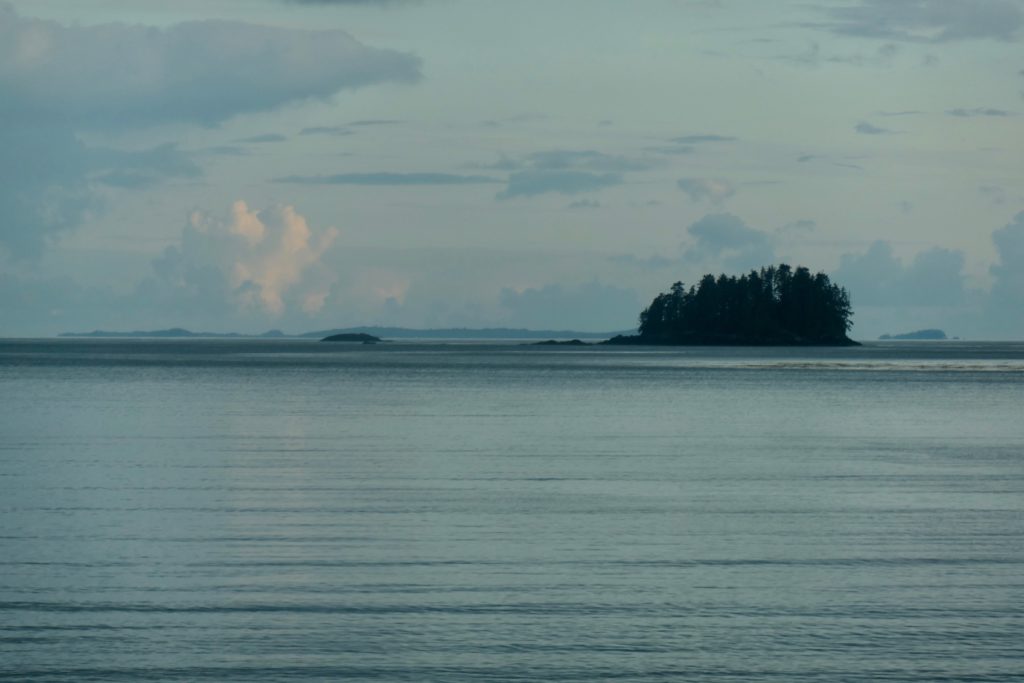
A slow start the next morning and then off to the Raptor Center. Here they take in and tend to all injured raptors and either release them or rehouse them. We started off with a talk about the work they do and were introduced to a juvenile bald eagle, who fixed me with a very stern look when I took out my camera to photograph him.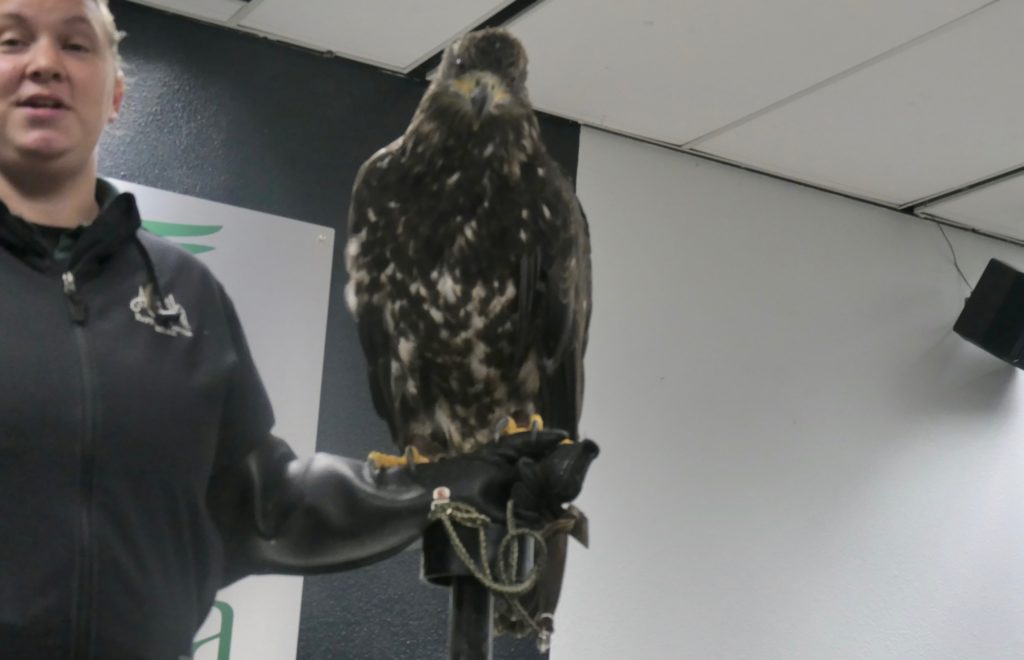
Unlike the Fortress of the Bears this was a most inspiring place with obviously dedicated staff and volunteers. We were taken first to the flight hall where the recovering birds are taught to fly again. The process is so simple but so effective. Raptors hate to walk on the ground so they are first placed on the ground at the bottom of a slope and their food about a metre off the ground half way up the hall. As they regain their ability to fly they move to higher and higher perches until they are flying freely. Then they are scheduled for release. Those who are too badly damaged to release are kept and become ambassadors for the breed going to schools to educate the young about raptors.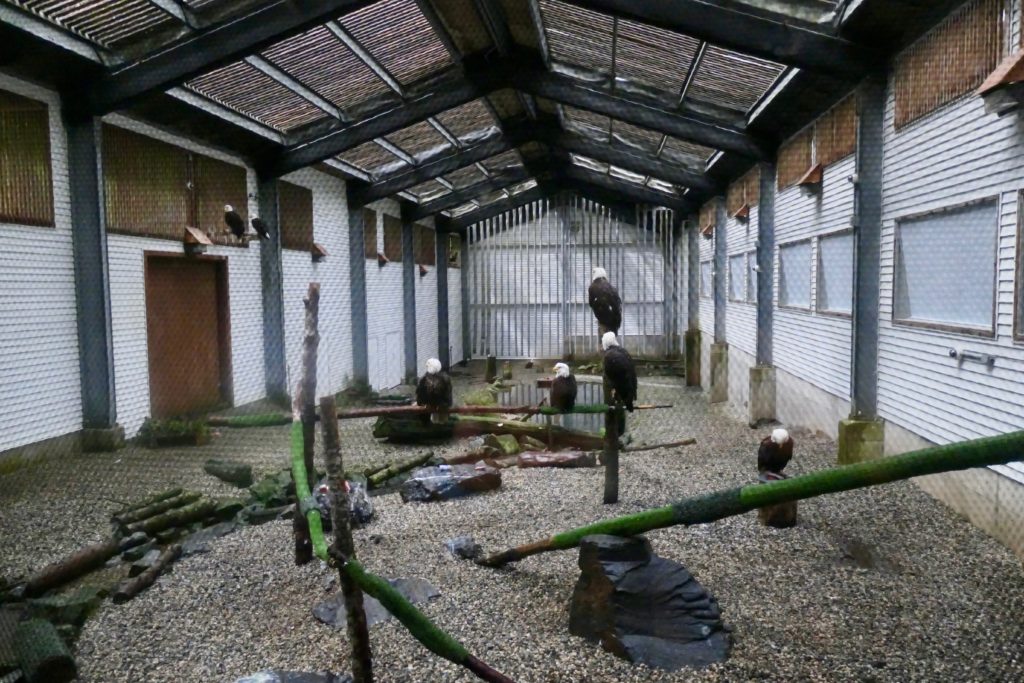
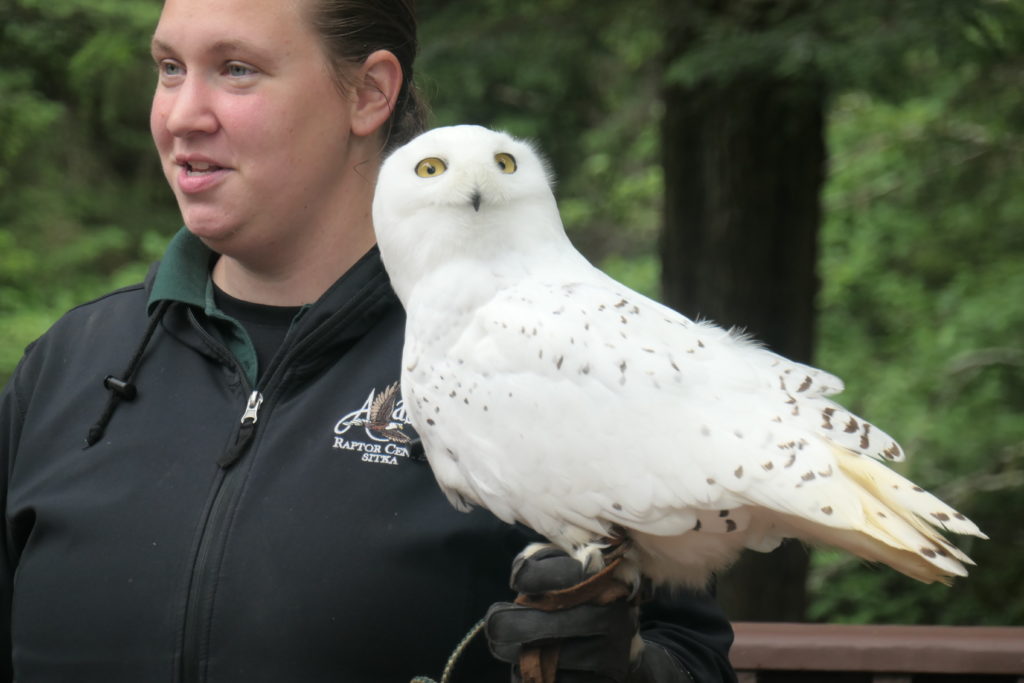
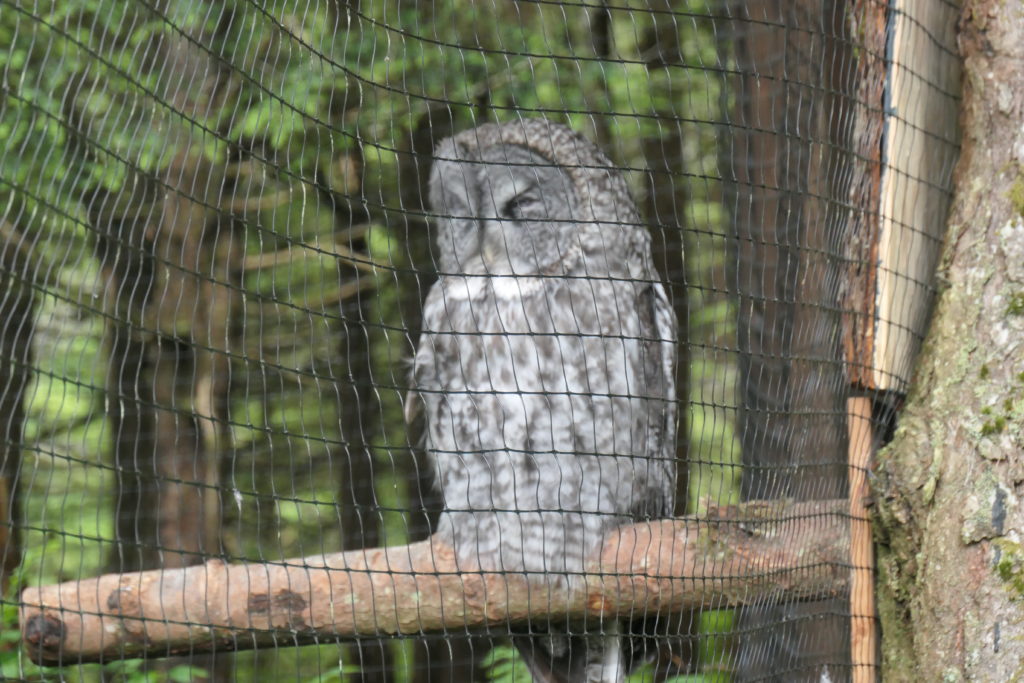
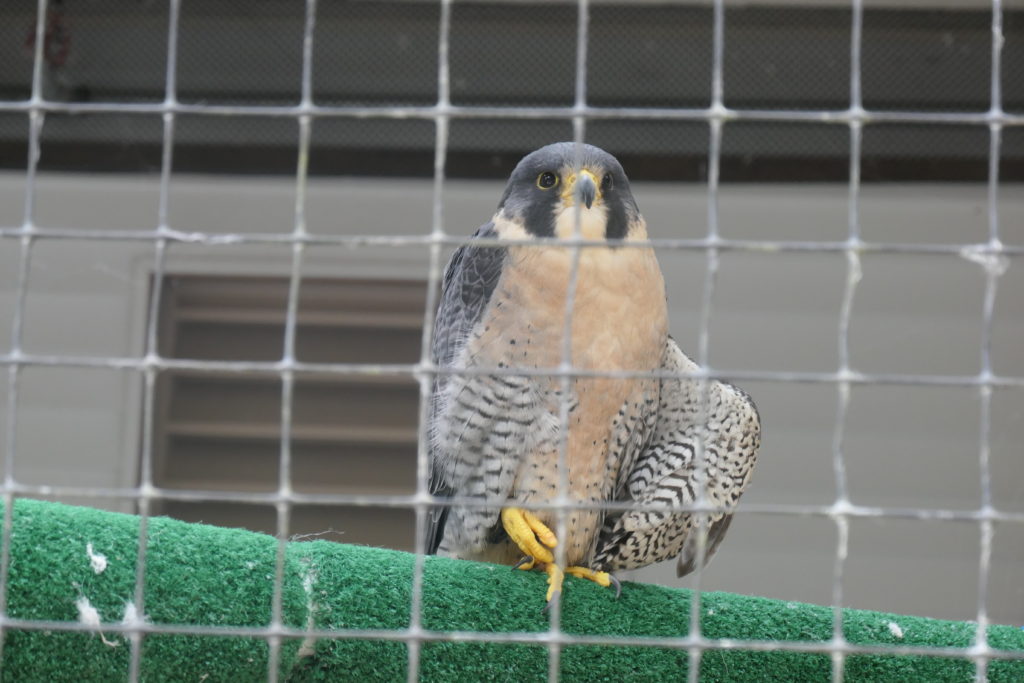
We had lunch and a local beer at the Sitka Inn and set out to visit some more galleries and buy a birthday present for Frankie. The Rose Gallery was a stand out with some marvelous bronzes by a husband and wife team, Jacques and Mary Regat, which we would have loved but didn’t have enough left in our budget having already bought two sculptures, a print by Ray Troll and a painting by Mary Deveau.